
views
X
Research source
Plant the peonies in well-draining, nutrient-rich soil at the correct depth, and you will be able to enjoy the flowers with minimal care for many years.
Selecting a Planting Location

Plant in autumn. Peonies thrive best when planted in autumn, before the first hard frost. Peonies may be planted in the spring, but these plants tend to grow more slowly, and may not bloom for a year or two.

Choose a location that receives six to eight hours of sunlight each day. If this is not available, peonies can still grow in areas with less sunlight, but their growth and bloom will be reduced. Peonies grow best in USDA Hardiness Zones 3 through 8, corresponding to minimum winter temperatures of -40 to +15ºF (-40 to -9.4ºC). If you are in Zone 8 or higher, peonies may benefit from afternoon shade, with full sunlight in the morning.
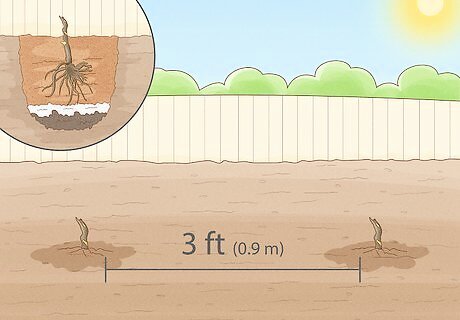
Space the peonies about three feet (0.9 meters) apart. Plan to keep each clump of peony tubers three feet (0.9 m.) apart. They are often used in flower beds, but keep them at away from trees and bushes, as woody root systems can compete with peonies for nutrients. Keeping peonies spaced apart and clearing weeds to allow for air circulation is important for avoiding fungal infections. Tree peony varieties will do better with four ft. (1.2 m) of space between them. If you are not sure what type of peony you have, see the planting peonies section below.
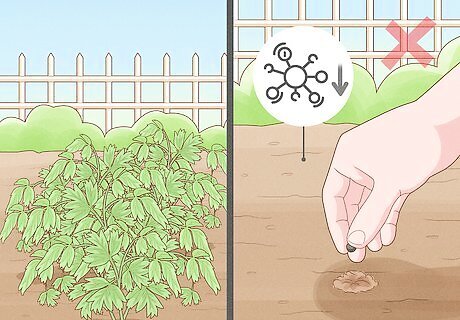
Avoid areas where peonies were previously planted. Peonies may develop problems if planted in areas where other peonies were previously grown. It is possible this is due to reduced soil nutrients, in which case the advice in the planting section below may compensate for this effect. There may be some risk of a surviving fungal infection as well, however, so plant at your own risk.
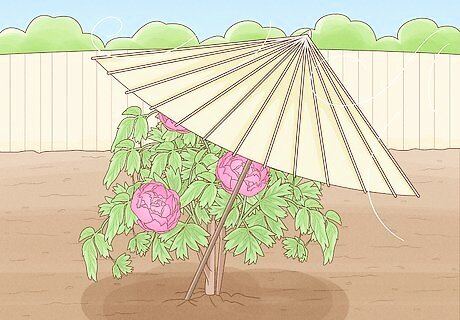
Provide shelter from strong winds. This is mostly a concern for tree peonies, which grow into small shrubs that can snap in the wind. However, if you are an area with unusually strong winds, plant any variety of peony in the shelter of a wall or fence. A large tree can also provide shelter, but should be located at least 10 ft. (3 m.) away so the roots do not compete with the peony.
Planting Peonies
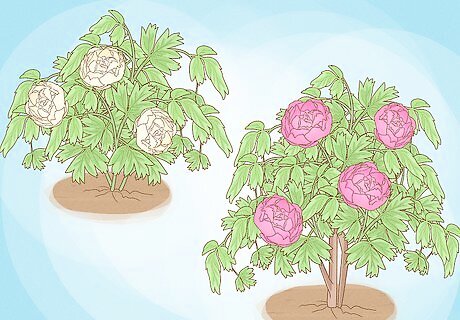
Identify your peony type. Peonies come in two varieties: herbaceous peonies and tree peonies. Herbaceous peonies are typically sold as root clumps, and grow into herb-like, green-stemmed flowers. Tree peonies usually have wooden stems attached to the root clump, and grow into woody-stemmed shrubs. Tree peonies also have a ridged bulge on the root with a different bark texture, where one variety of tree peony has been grafted onto another to combine the best qualities of each. You may follow these instructions for either variety, but be prepared to plant them at different depths: Herbaceous peonies grow when the top bud is planted at a depth of 2 inches (5 cm). Tree peonies grow best when the graft is planted at a depth of 4–6 inches (10–15 cm), with at least a tip of the top stem above the soil.

If your soil needs enriching, dig a hole 12–18 inches (30–46 centimeters) deep and equally wide. Peonies do not need to be planted this deep, but unless your flowerbed is already full of rich soil to this depth, a hole this deep is recommended so you can prepare rich, fertile soil for the deep peony roots that will develop after planting. A wide hole at least 18 in. (46 cm) across is recommended for the same reason. If your soil is rich, well-draining, and at least 18 in. (46 cm) deep, skip to the step "Plant the peony clump," below.
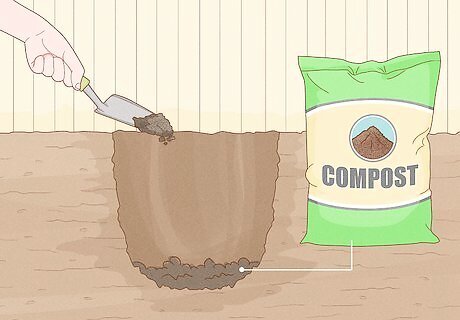
Add rich, well-draining soil to the bottom. Add 2–4 inches (5–10 centimeters) of dark compost, well-aged manure, or pine bark to the bottom of the hole. If your soil is slow-draining or poor in nutrients, make a 50/50 mix of this organic material and your garden soil, and keep it to one side to fill the hole later. To test soil drainage, dig a one ft (0.3 meters) hole and fill it with water. Wait until it drains, then fill the hole a second time. Measure how much it has drained after one hour, or measure after fifteen minutes and multiply by four to find the hourly drainage. Well-draining soil suitable for peonies should drain between 1 and 6 inches (2.5–15 cm) per hour.
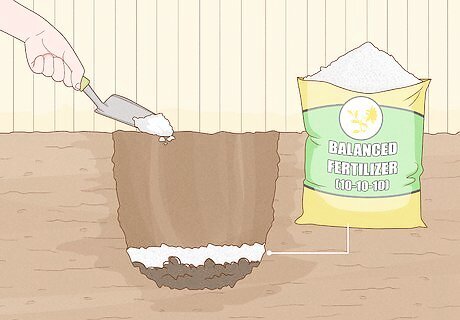
Add fertilizer and other soil additions (optional). To speed up the peony growth, you may add ¼ cup (60 mL) balanced (10-10-10) fertilizer to the bottom of the hole. Some gardeners also mix in ½ cup (120 mL) bone meal or superphosphate for additional nutrients. If pH testing reveals that your soil is acidic (below 6.0 pH), add a couple handfuls of lime to balance this out.

Fill most of the hole with packed, rich soil. Now that the extra-rich soil for the peonies' future roots has been prepared, fill most of the hole with well-draining, organic soil, leaving a few inches (several centimeters) of space at the top. The compost or other material you used to fill the bottom of the hole can be mixed with an equal amount of ordinary garden soil, then used for this purpose. Press the soil with your shovel as you fill it, tamping it down firmly.

Plant herbaceous peonies so the buds are 2 in. (5 cm) from the surface. Place the clump of peony tubers in the hole, with the small buds or "eyes" pointed upward, and the long roots pointed downward. The buds should be no more than 2 in. (5 cm) from the surface, or the plant may fail to emerge. Continue adding soil around the peony until the soil is level, tamping down gently to remove air pockets that can dry the plant out. Early-blooming varieties, especially in warm climates, may grow better if planted only 1 in. (2.5 cm) deep, so they can emerge early in the growing season.

Plant tree peonies so the graft is 4–6 in. (10–15 cm) below the surface. Tree peonies, with wooden stems attached to the root clumps, are sold with a stem grafted onto the roots. Find the ridged bulge on the rootstock where the stem and roots have been joined together, and plant the peonies so this bulge is 4–6 in. (10–15 cm) below the soil surface.

Water thoroughly. Give the newly planted tubers a thorough watering to help the soil settle around them. Until the first frost, or until the plants emerge if planting in spring, keep the soil moist, but not soggy.
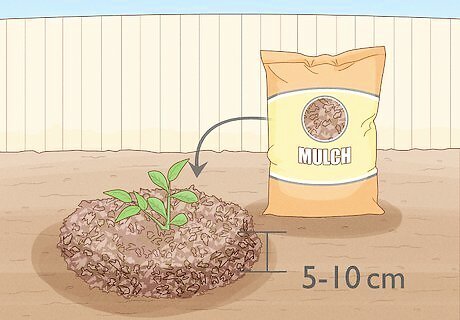
Mulch only during winter. Two to four in. (5–10 cm) of mulch, or a plastic mulch covering, can protect the peonies from winter frosts. However, this mulch should be removed after the last frost in spring, or the peonies may fail to break through this additional barrier. You do not need to water while the plants are dormant during winter.
Caring for Peonies

Water sparingly. Peonies are hardy, drought-tolerant plants, and only need about an inch (2.5 cm) of water a week during the summer. Increase the watering only if the peonies are dry and withered.
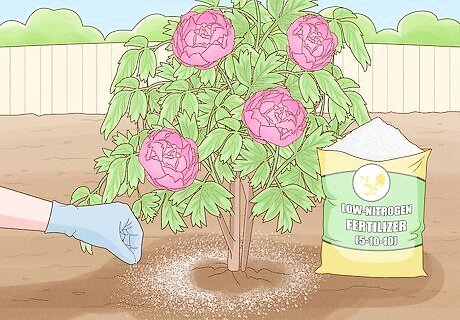
Fertilize sparingly. Fertilizer is optional, but you may apply a low nitrogen fertilizer, such as a 5-10-10 mix, or organic compost material, no more than once every few years. Apply this in a circle around the peonies, but not directly at the base of the plant. Different peony-growing guides give considerably varied information on fertilization. A conservative instruction is given here, because peonies will grow fine without fertilizer and can develop weak stems weak stems and fewer flowers if fertilizer is overused. If the stems become too weak to hold up the flowers, consider a gardener's tripod with a metal ring for supporting the stems.
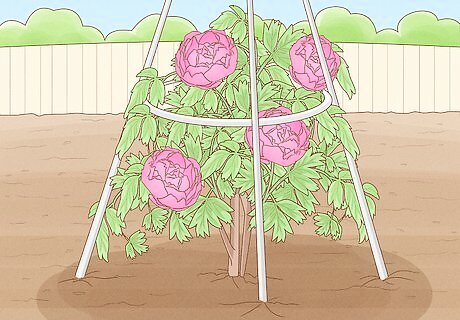
Create a support for the peonies if necessary. Large plants or varieties with especially large flowers will benefit from caging. A three legged-wire peony cage or a grid-like wire support will work well. Create the support in the spring.

Leave ants on the peonies. Ants are commonly found eating nectar from peony flowers, but this rarely causes harm to the plant. Peonies are resistant to most pests, but if you see an infection of other insects or fungus developing, seek advice from a local gardener or botanist who knows about pests in your regions. Most peony diseases are caused by moist conditions.

Remove dead flowers. Cut off dead flowers as soon as they fade. If you leave them on the plant, seeds will develop, which takes considerable nutrients out of the plant. Immediate deadheading will allow for stronger growth and a prolonged bloom.

Remove the leaves from tree peonies in autumn . If your peonies have grown into a shrub with woody stems, they are tree peonies. Remove the leaves in autumn, as cold weather and frosts begin. Leave the bare, wooden stems in place, as new flowers will grow from these next year. If the bare stems have holes bored into them, this may be a sign of pests. Contact a gardener or botanist in your area, familiar with local pest control.

Cut herbaceous peonies to ground level in autumn. Peonies are long-lasting perennials, so the roots will survive for many years but the flowers will grow, bloom, and die each spring. When the green stems of herbaceous peonies become brown and dead at the end of spring, cut the plant back to ground level. You may wait until the first heavy frost to do this. Warning: do not dispose of your dead peonies in the compost heap, as they may carry fungal infections that can spread to other plants this way. Burn them or throw them away instead.




















Comments
0 comment